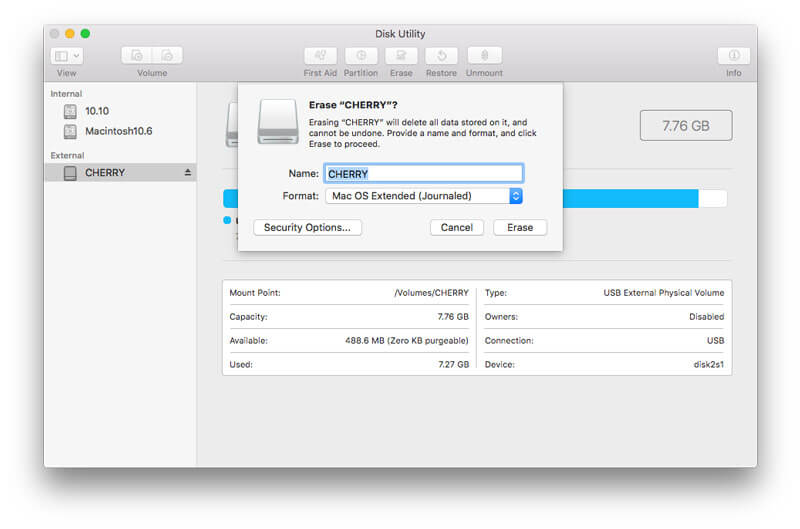

- #Format apple usb drive how to#
- #Format apple usb drive mac os#
- #Format apple usb drive android#
- #Format apple usb drive Pc#

Once the USB drive is formatted, you will see the following command. Step 6: Click Ok to allow Terminal access. In our case, we will use the following command and press Return. Under File System, you will mention the syntax of the new file format for your USB drive.

Step 5: Type the following command and press Return to format your USB drive.ĭisktuil erasedisk FILE_SYSTEM DISK_NAME DISK_INDENTIFIER Step 4: Among the listed storage devices, look for the USB drive Disk Name and Disk Identifier you wish to format. Step 3: After the Terminal app opens, type the following command and press Return to display all the storage devices mounted: diskutil list Step 2: Press Command + Spacebar to open Spotlight Search, type Terminal, and press Return. If you have a newer Mac model, use a dongle to connect the USB drive. Step 1: Insert your USB drive into the USB port on your Mac. Here’s how you can format your USB drive using Terminal on Mac. The Terminal app can also help you customize the interface and settings of your Mac. The second way of formatting a USB drive on your Mac is by using Terminal if you are an advanced user. You can format any drive using Disk Utility on Mac. You have successfully formatted your USB Drive. Step 10: Once you have selected the file format, click on Erase. Also, you will get the multi-device and platform compatibility. While cross-platform interoperability is great, it won’t let you copy files that are larger than 4GB.ĮxFAT: Choose this to overcome the 4GB file transfer limit of FAT32. MS-DOS (FAT32): Choose this option to make your USB drive work across different platforms.
#Format apple usb drive android#
After you choose this option, the drive won’t work with Windows computers or Android phones. This format gives the best compatibility with Macs.
#Format apple usb drive mac os#
Mac OS Extended: Select this option if you want to format the drive to make it compatible only with macOS-based systems. You get three file format options – Mac OS Extended, MS-DOS (FAT), and ExFat. Step 9: Click on Format to change the file format of your USB drive. Step 8: If you want to change the name of your USB drive, you can type the new name of your choice. Step 7: After you see all the storage information on your USB drive, click on Erase at the top-right corner. Step 6: Click on your USB drive name from the left menu in Disk Utility.

The double-click on Disk Utility to open it. Step 5: Type Disk Utility and press Return. Step 4: Click the Search Bar on the top-right corner in Applications. Step 3: Click on Applications from the left menu. Step 2: Press Command + Spacebar to open Spotlight Search, type Finder, and press Return. Step 1: Insert your USB drive into your Mac. Here’s how you can format your USB Drive on Mac. With the Disk Utility, you can check available storage on your device, repair any storage errors using First Aid, and format storage devices like USB Drives, Hard Drives, and SD Cards on your Mac. Format USB Drive on Mac Using Disk Utilityĭisk Utility is an built-in program available for macOS users to manage the storage devices on Mac.
#Format apple usb drive Pc#
If you are switching from a Mac to Windows PC or vice versa it’s a good idea to format your USB drive to change its file format for better compatibility.īut before you format a USB drive, you should remember to back up your data on cloud storage like iCloud, Google Drive or OneDrive. If you have a limited number of USB drives, formatting one of them will give you the peace of mind for storing more data when required. If you use a USB drive frequently for transferring or storing your data, you should consider formatting it to remove files you no longer require. This post will show you the two best ways to format a USB drive on Mac. Formatting a USB drive on your Mac can easily be done using the built-in apps.


 0 kommentar(er)
0 kommentar(er)
